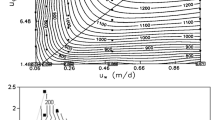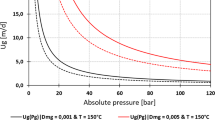Abstract
The method of characteristics, or fractional-flow theory, is extremely useful in understanding complex Enhanced Oil Recovery (EOR) processes and in calibrating simulators. One limitation has been its restriction to Newtonian rheology except in rectilinear flow. Its inability to deal with non-Newtonian rheology in polymer and foam EOR has been a serious limitation. We extend fractional flow methods for two-phase flow to non-Newtonian fluids in one-dimensional cylindrical flow, where rheology changes with distance from injection well. The fractional flow curve is then a function of position and we analyze the characteristic equations for two applications—polymer and foam floods. For polymer flooding, we present a semi-analytical solution for the changing fractional flow curve where characteristics and shocks collide. The semi-analytical solution is shown to give good agreement with the finite-difference simulation thus helping us understand the development and resolution of shocks. We discuss two separate cases of foam injection with or without preflush. We observe that the fractional flow solutions are more accurate than finite-difference simulations on a comparable grid and hence the method can be used to calibrate simulators. For SAG (alternating-slug) foam injection, characteristics and shocks collide, making the fractional-flow solution complex. Nonetheless, one can solve exactly for changing mobility near the well, to greater accuracy than with conventional simulation. The fractional-flow method extended to non-Newtonian flow can be useful both for its insights for scale-up of laboratory experiments and to calibrate computer simulators involving non-Newtonian EOR. It can also be an input to streamline simulations.
Similar content being viewed by others
References
AlSofi A.M., Blunt M.J.: Streamline-based simulation of non-Newtonian polymer flooding. SPE J. 15, 901–911 (2010)
Alvarez J.M., Rivas H., Rossen W.R.: A unified model for steady-state foam behavior at high and low foam qualities. SPE J. 6, 325–333 (2001)
Bedrikovetsky P.: Mathematical Theory of Oil and Gas Recovery. Kluwer Academic Publishing, The Netherlands (1993)
Bird R.B., Stewart W.E., Lightfoot E.N.: Transport Phenomena, 2nd ed. Wiley, New York (2002)
Blaker, T., Celius, H.K., Lie, T., Martinsen, H.A., Rasmussen, L., Vassenden, F.: Foam for gas mobility control in the snorre field: the FAWAG project. Paper SPE 56478, Presented at the 1999 SPE Annual Technical Conference and Exhibition, Houston, TX, 3–6 October 1999
Cheng, L.: Simulation studies of foam-acid diversion. PhD Dissertation, The University of Texas at Austin (2002)
Cheng, L., Reme, A.B., Shan, D., Coombe, D.A., Rossen, W.R.: Simulating foam processes at high and low foam qualities. Paper SPE 59287, Presented at the 2000 SPE/DOE Improved Oil Recovery Symposium, Tulsa, OK, 3–5 April 2000
Jamshidnezhad, M., Chen, C., Kool, P., Rossen, W. R.: Well stimulation and gravity segregation in gas improved oil recovery. Paper SPE 112375, Presented at the 2008 SPE International Symposium and Exhibition on Formation Damage Control held in Lafayette, Louisiana, USA, 13–15 February 2008; accepted for publication in SPE Reserv. Eval. Eng
Khatib, Z.I., Hirasaki, D.J., Falls, A.H.: Effects of capillary pressure on coalescence and phase mobilities in foams flowing through porous media. SPERE 3, 919–926 (1988)
Kibodeaux, K.R., Rossen, W.R.: Coreflood study of surfactant-alternating-gas foam processes. Paper SPE 38318, Presented at the 1997 SPE Western Regional Meeting, Long Beach, CA, 25–27 June 1997
Kloet, M.B., Renkema, W.J., Rossen, W.R.: Optimal design criteria for SAG foam processes in heterogeneous reservoirs. Paper SPE 121581, Presented at the 2009 SPE EUROPEC/EAGE Annual Conference and Exhibition, Amsterdam, The Netherlands, 8–11 June 2009
Kovscek, A.R. Radke, C.J.: Fundamentals of foam transport in porous media. In: Schramm, L.L. (ed.), Foams: Fundamentals and Applications in the Petroleum Industry. ACS Advances in Chemistry Series No. 242, Washington, DC (1994)
Lake L.: Enhanced Oil Recovery. Prentice Hall, Englewood Cliffs, NJ (1989)
Osterloh, W.T., Jante, M.J.: Effects of gas and liquid velocity on steady-state foam flow at high temperature. SPE 24179, SPE/DOE on EOR, Tulsa, OK, 22–24 April 1992
Pope G.A.: The application of fractional flow theory to enhanced oil recovery. SPE J. 10, 191–205 (1980)
Rhee H., Aris R., Amundson N.: First-Order Partial Differential Equations. Prentice Hall, Englewood Cliffs, NJ (1986)
Rong, J.G.: Experimental evaluation of foam in environmental remediation. PhD Dissertation, The University of Texas at Austin (2002)
Rossen W.R.: Foams in enhanced oil recovery. In: Prud’homme, R.K., Khan, S. (eds) Foams: Theory, Measurement, and Applications, Marcel Dekker, New York (1996)
Rossen W.R., Zeilinger S.C., Shi J.-X., Lim M.T.: Simplified mechanistic simulation of foam processes in porous media. SPE J. 4, 279–287 (1999)
Shan D., Rossen W.R.: Optimal injection strategies for foam IOR. SPE J. 9, 132–150 (2004)
Subramanian, S., Johns, R.T., Dindoruk, B.: Effect of fractional flow heterogeneity on compositional and immiscible displacements. Proceedings of 9th European Symposium on Improved Oil Recovery, The Hague, The Netherlands, Paper no. 060, October 20–22 (1997)
Subramanian S.K., Johns R.T., Dindoruk B.: Solution and upscaling of compositional and immiscible displacements in composite media. Petrol. Geosci. 5, 287 (1999)
Venkatraman, A., Johns, R.T., Rossen, W.R.: Fractional flow theory for non-Newtonian Polymer Flooding. Proceedings of 16th European Symposium on Improved Oil Recovery, Cambridge, UK, 12–14 April 2011
Walsh M.P., Lake L.W.: Applying fractional flow theory to solvent flooding and chase fluid. J. Petrol. Sci. Eng. 2, 281–303 (1989)
Wassmuth, F.R., Green, K.A., Randall, L.: Details of in-situ foam propagation exposed with magnetic resonance imaging. SPEREE, 135–145, April 2001
Wu Y.S., Pruess K., Witherspoon P.A.: Displacement of a Newtonian fluid by a non-Newtonian fluid in a porous medium. Transp. Porous Media 6, 115–142 (1991)
Wu Y.S., Pruess K., Witherspoon P.A.: Flow and displacement of bingham non-newtonian fluids in porous media. SPERE 7, 369–376 (1992)
Wu Y.S., Pruess K., Chen X.Z.: Buckley–Leverett flow in composite porous media. SPE Adv. Technol. 1(2), 36 (1995)
Xu Q., Rossen W.R.: Experimental study of gas injection in surfactant-alternating-gas foam process. SPE Reserv. Eval. Eng. 7, 438–448 (2004)
Yi, X.: Model for displacement of Herschel–Bulkley non-Newtonian fluid by newtonian fluids in porous media and its application in fracturing-fluid cleanup. Paper SPE 86491, Presented at the Formation Damage Symposium, Lafayette, LA, 18–20 February 2004
Zhou Z.H., Rossen W.R.: Applying fractional-flow theory to foam processes at the “limiting capillary pressure”. SPE Adv. Technol. 3(1), 154–162 (1995)
Author information
Authors and Affiliations
Corresponding author
Rights and permissions
About this article
Cite this article
Rossen, W.R., Venkatraman, A., Johns, R.T. et al. Fractional Flow Theory Applicable to Non-Newtonian Behavior in EOR Processes. Transp Porous Med 89, 213–236 (2011). https://doi.org/10.1007/s11242-011-9765-2
Received:
Accepted:
Published:
Issue Date:
DOI: https://doi.org/10.1007/s11242-011-9765-2




